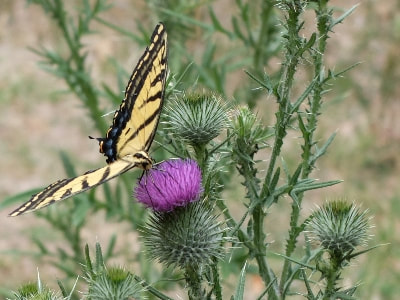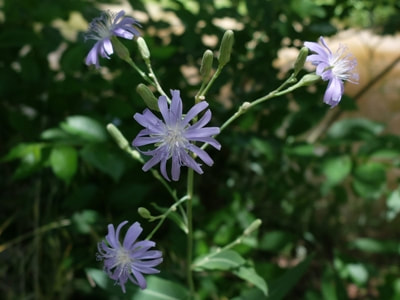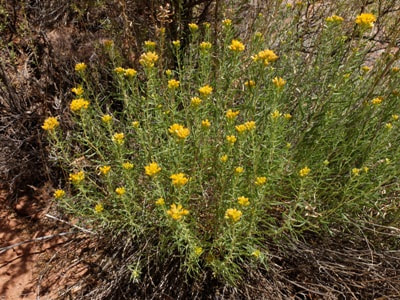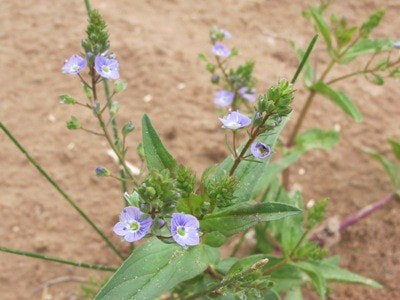|
Found in disturbed areas, meadows, roadsides
Seen blooming in July at Agua Caliente Spring, Abiquiu The Bull Thistle grows to six feet tall with many spreading branches. It has masses of long, dark green, intensely spiny leaves and many large, prickly flower heads at the end of the branches that are up to 2 inches high. Below the flowers are many long, stiff, yellow or green spines. It is an invasive weed and considered noxious in New Mexico. Nevertheless the purple flower heads are striking and this magnificent Two-tailed Swallowtail butterfly was enjoying the nectar. Bull thistle root can be eaten and is best used when mixed with other vegetables. Young flower stems can be cooked and young leaves can be eaten in a salad or tossed into a sauté. The taste is somewhat bland but the prickles need to be removed from the leaves before the leaves can be eaten! The flower buds can be cooked and used like globe artichokes, but they are smaller. Bull thistle seeds can be roasted. Source. If you trying to identify a different flower then you can check what other flowers bloom this month. If you cannot identify a flower from the website send a photo and where you took it to contact@rockymountainsflora.com. Read online for tips.
0 Comments
Found in moist meadows and woods
Seen blooming in July by the Tierra Azul Acequia Grassleaf Lettuce grows to 3 feet with a single, erect stem that has a milky sap when broken. The long narrow leaves grow mostly on the lower half of the stem, the lowest leaves are broader and have shallow lobes. The blue to lavender flowers have toothed petals. They resemble Chicory but the Chicory flowers are larger and grow from the stem rather than the tops of branches, and the Chicory plant is taller. The seed head is a dandelion-like plume of white fluff. It is related to the lettuce we put in our salads and young leaves can be eaten raw or cooked but have a bitter taste. If you trying to identify a different flower then you can check what other flowers bloom this month. If you cannot identify a flower from the website send a photo and where you took it to contact@rockymountainsflora.com. Read online for tips. Found in floodplains, washes, alkaline/saline soils
Seen blooming in July in Red Wash Canyon Here is another yellow shrub that at first glance looks like a small version of the widespread Chamisa, but a closer look reveals some differences. It only grows to about two feet tall compared to the Chamisa which can be from two to nine feet tall and scruffy. Its straw-colored stems have few branches and are not white hairy. Leaves are narrow and up to two inches long with smooth edges and sometimes shallow teeth. Flowers have a faint, sweet fragrance and grow in dense clusters at the top of the stem. Flowers grow in a round cluster with no petals and 8 to 21 yellow disk flowers, Chamisa has only 5 disk flowers. Southern Goldenbush is poisonous to livestock. It was used by Native Americans as a lotion to heal an infant's navel, a poultice was applied for muscular pain and leaves were chewed for coughs. Source. If you trying to identify a different flower then you can check what other flowers bloom this month. If you cannot identify a flower from the website send a photo and where you took it to contact@rockymountainsflora.com. Read online for tips. Water Hemlock, Spotted Cowbane, Beaver Poison,Cicuta maculate,Parsley/Carrot Family (Apiaceae)6/26/2020 Found in wet soil, marshes, ditches
Seen blooming in June by the Rio Chama This is a Public Service Announcement! Do not touch any part of this plant because it is the “most violently toxic plant in North America” according to the USDA Agricultural Research Service. It is very similar in appearance to other members of the Parsley/Carrot family, some of which are edible or medicinal, so avoid all unless you are an expert. It grows from two to seven feet tall with stout, hollow stems. Leaves are divided into toothed, lance-shaped leaflets. Distinguishing features of the Water Hemlock are the prominent veins in the leaflets that end in the notches between the teeth and the purplish spots at the base of the stem where it meets the ground. Flower clusters of tiny, white flowers are 3" to 6" across. All parts of the plant are toxic, particularly the root. Browsing livestock can easily pull a root from the soil when browsing new green growth. A single section of root can kill a cow, hence the common name of Cowbane. Despite its toxicity it was used by Native Americans as an insecticide, for sterility if ingested, ceremonially, to help with broken bones and bruises, and as a poison for hunting. Source. If you trying to identify a different flower then you can check what other flowers bloom this month. If you cannot identify a flower from the website send a photo and where you took it to contact@rockymountainsflora.com. Read online for tips. Found in shallow water, moist areas, stream sides
Seen blooming in June by the Rio Chama Although common along local waterways Water Speedwell is hard to spot because of its small flowers. It usually grows sprawling to two feet with erect flower stems growing from the base of the leaves and the end of the branches. Leaves have small teeth, clasp the stem and are up to three inches long. Tiny flowers are ¼ inch across and grow in clusters of 30 or more flowers. The flowers have four lavender blue or violet petals with purple lines and two long stamens. Leaves are edible raw or cooked and are rich in vitamin C. They have a subtle flavor and can be added to salads or used as a potherb. When used in salads they go better with a lemon dressing than vinegar. The root and the leaves are used medicinally to improve appetite, as a blood tonic, to improve urine flow, in the treatment of scurvy, and to treat burns and skin ulcers. Source. If you trying to identify a different flower then you can check what other flowers bloom this month. If you cannot identify a flower from the website send a photo and where you took it to contact@rockymountainsflora.com. Read online for tips. |
AuthorI am Marilyn Phillips, a native of England, whose love of nature and the outdoors from childhood brought me by a circuitous route to Crested Butte, Colorado in 1993 and 16 years later to northern New Mexico. My exploration of the many trails in these areas, my interest in wildflowers and photography, and career in computer system design came together in this creation. If you have any corrections, comments or questions, please contact me by email. Archives
September 2024
Categoriescopyright © 2020
|







 RSS Feed
RSS Feed